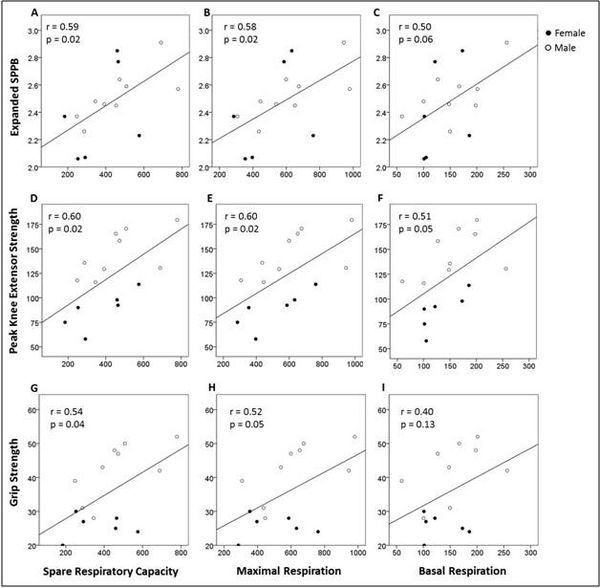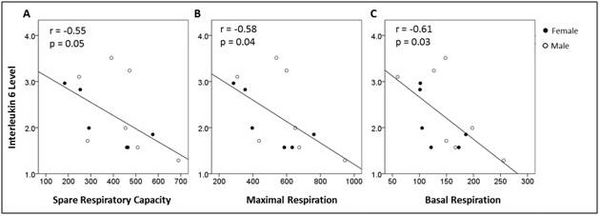Tyrrell 2015 Abstract MiPschool Greenville 2015
| Blood-cell bioenergetics are associated with physical function and inflammation in overweight/obese older adults. |
Link:
Tyrrell DJ, Bharadwaj MJ, VanHorn CG, Marsh AP, Nicklas BJ, Molina AJA (2015)
Event: MiPschool Greenville 2015
Physical function and strength decline with age and lead to limited mobility and independence in older adults [1]. Alterations in mitochondrial function are thought to underlie numerous age-related changes, including declining physical ability. Recent studies suggest that systemic changes in bioenergetic capacity may be reported by analyzing mitochondrial function in circulating cells [2,3,4]. The objective of this study was to determine whether the bioenergetic capacity of peripheral blood mononuclear cells (PBMCs) is related to differences in physical function among older, overweight/obese, adults. To address this, we tested the hypothesis that greater PBMC respirometric capacity would be associated with better physical function, muscular strength, leg lean mass, and muscle quality. Furthermore, we tested whether the respirometric capacity of PBMCs is related to cellular composition and inflammatory status reported by interleukin 6 (IL-6).
Fasted PBMC respiration (pmol/min/500,000 cells), expanded short physical performance battery (Ex-SPPB), peak knee extensor (KE) strength (Nm), grip strength (kg), leg lean mass (kg, via dual energy X-ray absorptiometry [DXA]), muscle quality (Nm/kg), and plasma IL-6 (pg/mL) were analyzed in 15 well-functioning, community-dwelling, sedentary overweight/obese older men (n=9) and women (n=6) aged 65 to 78 (mean 68.3 ± 3.5 years). Pearson and partial correlations were calculated to determine associations between PBMC respiration and these variables.
Higher maximal respiration of PBMCs was associated with better Ex-SPPB (r = 0.58, p = 0.02), greater KE strength (r = 0.60, p = 0.02), greater grip strength (r = 0.52, p = 0.05) and lower IL-6 (r = -0.58, p = 0.04). Higher spare respiratory capacity was associated with better Ex-SPPB (r = 0.59, p = 0.02), greater KE strength (r = 0.60, p = 0.02), greater grip strength (r = 0.54, p = 0.04), greater leg muscle quality (r = 0.56, p = 0.04), and lower IL-6 (r = -0.55, p = 0.05). Monocyte and lymphocyte counts were not related to PBMC respiratory capacity.
Our results indicate that respirometric profiles of readily obtainable blood cells are associated with physical function and strength. Future studies should be undertaken in order to determine whether blood-based bioenergetic profiling can provide an objective index of systemic mitochondrial health.
• Keywords: PBMC
• O2k-Network Lab: US NC Winston-Salem Molina AJA
Labels: MiParea: Respiration Pathology: Aging;senescence, Obesity
Organism: Human Tissue;cell: Blood cells
Event: Oral
Affiliations
1-Sticht Center Aging Dept Internal Med, Section Gerontology Geriatrics, Wake Forest School Med, Winston-Salem, NC; 2-Dept Health Exercise Sc, Wake Forest Univ, Winston-Salem, NC, USA. - [email protected]
Figures
Figure 1. Expanded SPPB plotted against (A) SRC (Maximal Respiration minus Basal Respiration; pmol/min/500,000 cells), (B) Maximal Respiration (pmol/min/500,000 cells), and (C) Basal Respiration (pmol/min/500,000 cells) in peripheral blood mononuclear cells. Peak knee extensor strength (Nm) plotted against (D) SRC, (E) Maximal Respiration, and (F) Basal Respiration in peripheral blood mononuclear cells. Grip strength (kg) plotted against (G) SRC, (H) Maximal Respiration, and (I) Basal Respiration in peripheral blood mononuclear cells.
SPPB, short physical performance battery; SRC, spare respiratory capacity. N=15.
Figure 2. Interleukin-6 level (pg/mL) plotted against: (A) SRC (Maximal Respiration minus Basal Respiration; pmol/min/500,000 cells), (B) Maximal Respiration (pmol/min/500,000 cells), and (C) Basal Respiration (pmol/min/500,000 cells) in peripheral mononuclear cells. SRC, spare respiratory capacity. N=13.
References and acknowledgements
- Guralnik JM, Ferrucci L, Simonsick EM, Salive ME, Wallace RB (1995) Lower-extremity function in persons over the age of 70 years as a predictor of subsequent disability. N Engl J Med 332:556-61.
- Coen PM, Jubrias SA, Distefano G, Amati F, Mackey DC, Glynn NW, Manini TM, Wohlgemuth SE, Leeuwenburgh C, Cummings SR, Newman AB, Ferrucci L, Toledo FGS, Shankland E, Conley KE, Goodpaster BH (2013) Skeletal muscle mitochondrial energetics are associated with maximal aerobic capacity and walking speed in older adults. J Gerontol A Biol Sci Med Sci 68:447-55.
- Chacko BK, Kramer PA, Ravi S, Benavides GA, Mitchell T, Dranka BP, Ferrick D, Singal AK, Ballinger SW, Bailey SM, Hardy RW, Zhang J, Zhi D, Darley-Usmar VM (2014) The bioenergetic health index: a new concept in mitochondrial translational research. Clin Sci (Lond) 127:367-73.
- Tyrrell DJ, Bharadwaj MS, Van Horn CS, Kritchevsky SB, Nicklas BJ, Molina AJA (2014) Respirometric profiling of muscle mitochondria and blood cells are associated with differences in gait speed among aommunity-dwelling older adults. J Gerontol Series A: Biol Sc Med Sc. Epub Online First.

